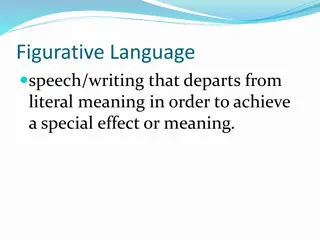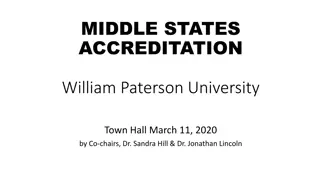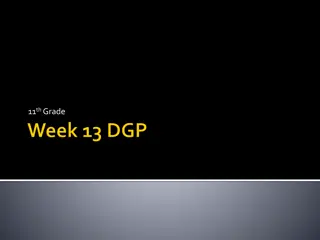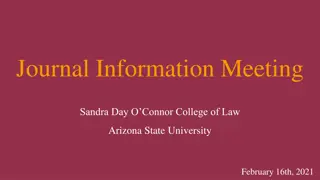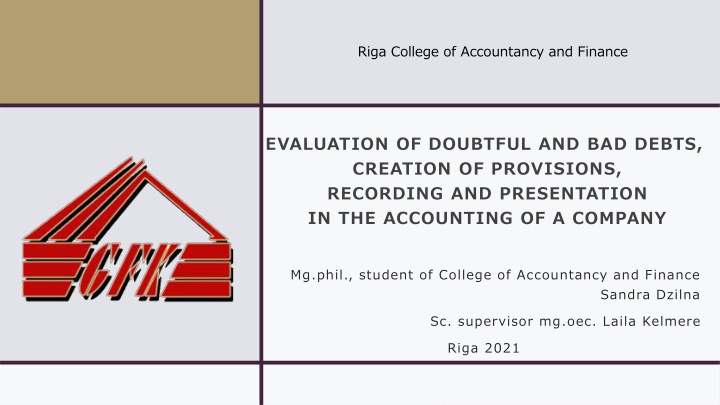
Doubtful and Bad Debts in Company Accounting
Explore the evaluation, creation of provisions, recording, and presentation of doubtful and bad debts in company accounting. This research delves into the impact of doubtful debtors on tax calculation, the relevance of legislation, and the effects of the pandemic on financial reporting data. Learn about the recognition and valuation of debtors in financial accounting, as well as the necessary revisions in criteria due to Covid-19.
Download Presentation

Please find below an Image/Link to download the presentation.
The content on the website is provided AS IS for your information and personal use only. It may not be sold, licensed, or shared on other websites without obtaining consent from the author. If you encounter any issues during the download, it is possible that the publisher has removed the file from their server.
You are allowed to download the files provided on this website for personal or commercial use, subject to the condition that they are used lawfully. All files are the property of their respective owners.
The content on the website is provided AS IS for your information and personal use only. It may not be sold, licensed, or shared on other websites without obtaining consent from the author.
E N D
Presentation Transcript
Riga College of Accountancy and Finance EVALUATION OF DOUBTFUL AND BAD DEBTS, CREATION OF PROVISIONS, RECORDING AND PRESENTATION IN THE ACCOUNTING OF A COMPANY Mg.phil., student of College of Accountancy and Finance Sandra Dzilna Sc. supervisor mg.oec. Laila Kelmere Riga 2021
Limited Liability Company College of Accountancy and Finance is a commercial company founded by a legal entity About the College (I) The College mainly specializes in the preparation of professionally qualified accountants of the fourth level and business professionals More than 2322 graduates have already received state-recognized diplomas for the first level professional higher education The places of implementation of the College academic activitiy are in Riga, Daugavpils and Valmiera 2
The College implements the first level professional higher education study programs in the following study fields or directions: About the College (II) 1. Economics, study program Accounting and Finance 2. Management, administration and real estate management, study program Business and Finance 3
. To explore recognition, accounting and valuation of doubtful and bad debtors, and their presentation in the accounts of an enterprise in accordance with the existing laws and regulations Goal of the research 4
1. To explore and analyse acts of legislation, information available in specialist literature and statistics on doubtful and bad debtors Tasks of the research 2. To describe and evaluate the accounting of receivables and documents related to recognition of doubtful and bad debts 3. To analyse and describe presentation of debtors in financial accounting 4. To explore and describe the creation of provisions for doubtful debtors 5. To analyse the impact of doubtful and bad debtors on tax calculation 5
Impact of the pandemic on financial reporting data Topicality of the chosen theme in the context of Covid-19 (I) When preparing the financial report for 2020, the impact of the pandemic on the stability of economic performance of an enterprise at the reporting date must be taken into account Law On Measures for the Prevention and Suppression of Threat to the State and Its Consequences Due to the Spread of COVID-19 dated 21.03.2020 The criteria for recognizing doubtful debtors may need to be revised 6
1. Monographic method (information on the selection, data processing and analysis for the research topic) Research methodology 2. Analytical method (Research object structure and analysis) 3. Graphical method (Characteristics of the research object) 7
The concept of doubtful receivables, evaluation and provisioning The concept of bad debtors, evaluation and exclusion from financial statements Research results (I) Bad debts are the amounts that are considered lost without hope of recovery Doubtful debts are receivables which receipt probability is questioned Doubtful receivables are provided with provisions so as to be seen in the balance sheet at the net value Bad debts are excluded from the accounts 8
Impact of provisions for doubtful debts on EIT taxable income In Latvia, the EIT rate is 25 % Research results (II) (base amount / 0,8*20 %) Writing off the doubtful receivable, increases the base taxable income of an enterprise Except in cases where the company has taken all appropriate measures for debt collection and recovery within the meaning of Section 9, Paragraph 1 of the EIT Law, and the conditions laid by the law are met The base taxable with the enterprise income tax shall include the amount of the debts of debtors and the debt has not been recovered within 36 months from the day of the creation of provision 9
Section 105 of the VAT Law describes a special procedure for the adjustment of input tax on bad debts Research results (III) VAT rate in Latvia 21 % has the right to reduce the amount paid into the State budget by the amount of the tax of bad debt, if all the conditions referred to in this Paragraph of Section are met and the debt has arisen during the last three taxation years when the court has approved completion of the insolvency proceedings of the recipient of goods or services 10
Legislation provides that identifying receivables in a timely manner will allow the enterprise to take all necessary measures so that in case the debtor's debt cannot be recovered, to avoid the increase of the base of enterprise income tax Summary (I) At present, it is impossible to take all necessary measures, because the condition of 36-month period is in force 11
Customer monitoring should be performed in accordance with pre-assessed risks and lending policies according to the needs of an enterprise Summary (III) At present, risks are assessed subjectively. There are two trends: 1. To reduce post-payment time (precautionary principle). 2. To increase post-payment time (hoping for stabilization and governmental support) 12
Review regularly whether the current policy regarding debt collection is effective, whether the criteria of Section 9 of the Enterprise Income Tax Law and Section 105 of the Value Added Tax Law for reducing tax costs are met Summary (V) Follow the Government policies in the state that influence economic processes in the situation of crisis, including the policy of awarding grants and benefits which promote the solvency of debtors. 13
Thank you for your attention! Time for questions 14









